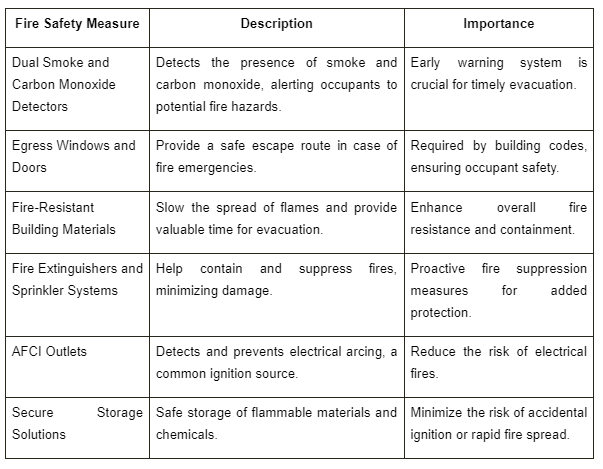Are you dreaming of transforming your underutilized basement into a functional living space? Though basement remodels offer exciting possibilities, they also present unique fire safety challenges.
As an integral part of your home, prioritizing fire safety from the planning stage is crucial. This comprehensive guide explores critical fire safety considerations, equipping you with strategies to create a haven without compromising your vision.
Understanding the Importance of Fire Safety in Basement Remodels
Fire safety is a critical aspect of basement remodeling. Each year, home fires in the United States claim around 4,000 lives, often igniting at night when families are most vulnerable. Basements pose a unique risk in these scenarios. Being confined spaces that may store flammable materials, basements become potential starting points for rapid fire spread.
The significance of fire safety becomes particularly evident in incidents like a recent fire in a Naperville duplex, which resulted in injuries and extensive damage. Such events serve as stark reminders of the risks posed by inadequate fire safety measures.
The importance of fire safety in basement remodeling cannot be overstated, particularly in areas like Naperville. Undertake basement remodeling Naperville to prioritize fire safety from the initial planning stages to safeguard your investment and, more importantly, protect the lives of your loved ones.
Key Fire Safety Measures to Implement
-
Dual Smoke and Carbon Monoxide Detectors
The installation of dual smoke and carbon monoxide detectors is an essential first step in any basement remodel. These life-saving devices provide comprehensive safety coverage, alerting you to the presence of deadly smoke and toxic gasses. Optimal placement on ceilings and near sleeping areas, coupled with regular testing and timely battery replacements, is crucial for maintaining their effectiveness.
-
Egress Windows and Doors
Building codes often mandate the presence of egress windows and doors in basement living spaces, providing a critical escape route in case of fire emergencies. During your remodel, ensure these openings meet legal requirements and are easily accessible, offering a safe path to the outdoors.
-
Fire-Resistant Building Materials
Choosing the right building materials can significantly impact fire safety in your basement. Fire-resistant materials, such as fire-retardant-treated wood and fire-resistant coatings, can slow the spread of flames and provide valuable time for evacuation. Incorporate these materials into your remodel, particularly for walls, ceilings, and floors, to create a more fire-resilient environment.
-
Fire Extinguishers and Sprinkler Systems
While prevention is key, being prepared for the unexpected is equally important. Strategic placement of fire extinguishers throughout your basement can aid in containing small fires before they escalate. Additionally, consider installing a sprinkler system, as these can effectively suppress fires and minimize damage to your property.
-
Electrical Safety in Basement Remodels
Electrical hazards are a leading cause of residential fires, making electrical safety a priority during your basement remodel. Incorporate AFCI (Arc Fault Circuit Interrupter) outlets, which are designed to detect and prevent electrical arcing, a common ignition source for fires. Furthermore, a professional electrical inspection can identify and rectify any potential safety issues before they become a threat.
-
Safe Storage Solutions
Basements are often used for storing various items, including flammable materials and chemicals. During your remodel, implement secure and fire-resistant storage solutions, such as fire-resistant glass for windows and designated storage areas for combustible items. By taking proactive measures, you can significantly reduce the risk of accidental ignition or the rapid spread of fires.
-
Navigating Building Codes and Legal Requirements
Adhering to relevant building codes and standards is not only a legal obligation but also a crucial step in ensuring the safety of your basement remodel. Consult with local authorities and obtain the necessary permits, ensuring your project meets all fire safety requirements. Compliance with these regulations guarantees the efficacy of your fire prevention strategies and protects your investment in the long run.
-
Regular Maintenance and Fire Safety Checks
Once your basement remodel is complete, the journey towards fire safety continues. Regular maintenance, including testing smoke detectors monthly and replacing batteries annually, is essential for keeping your safety measures operational. Additionally, schedule annual professional inspections to identify any potential issues and maintain the effectiveness of your fire safety systems.
Fire Safety Measures for Basement Remodels

Frequently Asked Questions (FAQs)
What’s the most overlooked fire safety feature in basement remodels
One of the most commonly overlooked fire safety features in basement remodels is the presence of adequate egress routes. Many homeowners fail to prioritize the installation of properly sized egress windows or doors, compromising a safe escape path in emergencies.
How often should smoke detectors and fire extinguishers in the basement be tested or replaced?
Smoke detectors should be tested monthly, and batteries should be replaced at least once a year. As for fire extinguishers, they should be inspected annually by a professional to ensure they are properly charged and in working condition.
Can I install a sprinkler system in my basement by myself, or do I need a professional?
While it is possible to install a sprinkler system in your basement as a DIY project, it is highly recommended to hire a professional. Proper installation and inspection are crucial to ensure the system functions correctly and meets all building codes and safety standards.
Minimize the risk of accidental ignition or rapid fire spread.
Published by: Khy Talara










